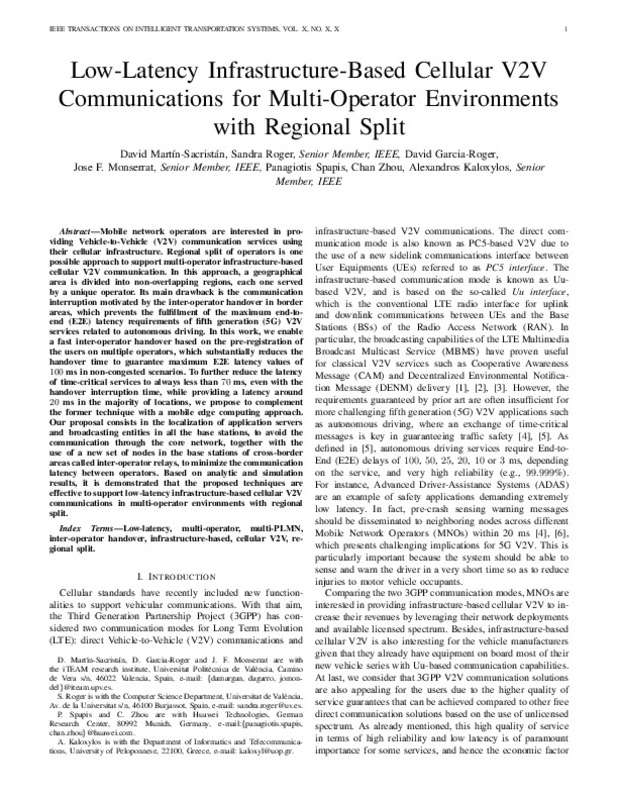Martín-Sacristán, D.; Roger, S.; Garcia-Roger, D.; Monserrat Del Río, JF.; Spapis, P.; Zhou, C.; Kaloxylos, A. (2021). Low-Latency Infrastructure-Based Cellular V2V Communications for Multi-Operator Environments With Regional Split. IEEE Transactions on Intelligent Transportation Systems. 22(2):1052-1067. https://doi.org/10.1109/TITS.2019.2962097
Por favor, use este identificador para citar o enlazar este ítem: http://hdl.handle.net/10251/201899
|
Título:
|
Low-Latency Infrastructure-Based Cellular V2V Communications for Multi-Operator Environments With Regional Split
|
|
Autor:
|
 Martín-Sacristán, David
Martín-Sacristán, David
 Roger, Sandra
Roger, Sandra

 Garcia-Roger, David
Garcia-Roger, David

 Monserrat del Río, Jose Francisco
Spapis, Panagiotis
Zhou, Chan
Kaloxylos, Alexandros
Monserrat del Río, Jose Francisco
Spapis, Panagiotis
Zhou, Chan
Kaloxylos, Alexandros
|
|
Entidad UPV:
|
Universitat Politècnica de València. Instituto Universitario de Telecomunicación y Aplicaciones Multimedia - Institut Universitari de Telecomunicacions i Aplicacions Multimèdia
Universitat Politècnica de València. Escuela Técnica Superior de Ingenieros de Telecomunicación - Escola Tècnica Superior d'Enginyers de Telecomunicació
|
|
Fecha difusión:
|
|
|
Resumen:
|
[EN] Mobile network operators are interested in providing Vehicle-to-Vehicle (V2V) communication services using their cellular infrastructure. Regional split of operators is one possible approach to support multi-operator ...[+]
[EN] Mobile network operators are interested in providing Vehicle-to-Vehicle (V2V) communication services using their cellular infrastructure. Regional split of operators is one possible approach to support multi-operator infrastructure-based cellular V2V communication. In this approach, a geographical area is divided into non-overlapping regions, each one served by a unique operator. Its main drawback is the communication interruption motivated by the inter-operator handover in border areas, which prevents the fulfillment of the maximum end-to-end (E2E) latency requirements of fifth generation (5G) V2V services related to autonomous driving. In this work, we enable a fast inter-operator handover based on the pre-registration of the users on multiple operators, which substantially reduces the handover time to guarantee maximum E2E latency values of 100 ms in non-congested scenarios. To further reduce the latency of time-critical services to always less than 70 ms, even with the handover interruption time, while providing a latency around 20 ms in the majority of locations, we propose to complement the former technique with a mobile edge computing approach. Our proposal consists in the localization of application servers and broadcasting entities in all the base stations, to avoid the communication through the core network, together with the use of a new set of nodes in the base stations of cross-border areas called inter-operator relays, to minimize the communication latency between operators. Based on analytic and simulation results, it is demonstrated that the proposed techniques are effective to support low-latency infrastructure-based cellular V2V communications in multi-operator environments with regional split.
[-]
|
|
Palabras clave:
|
Handover
,
Time factors
,
Servers
,
3GPP
,
Long Term Evolution
,
Intelligent transportation systems
,
Low-latency
,
Multi-operator
,
Multi-PLMN
,
Inter-operator handover
,
Infrastructure-based
,
Cellular V2V
,
Regional split
|
|
Derechos de uso:
|
Reserva de todos los derechos
|
|
Fuente:
|
IEEE Transactions on Intelligent Transportation Systems. (issn:
1524-9050
)
|
|
DOI:
|
10.1109/TITS.2019.2962097
|
|
Editorial:
|
Institute of Electrical and Electronics Engineers
|
|
Versión del editor:
|
https://doi.org/10.1109/TITS.2019.2962097
|
|
Código del Proyecto:
|
info:eu-repo/grantAgreement/MCIU//RYC-2017-22101/
|
|
Agradecimientos:
|
The work of S. Roger was partially supported by the Spanish Ministry of Science, Innovation and Universities through grant number RYC-2017-22101.
|
|
Tipo:
|
Artículo
|







![[Cerrado]](/themes/UPV/images/candado.png)


